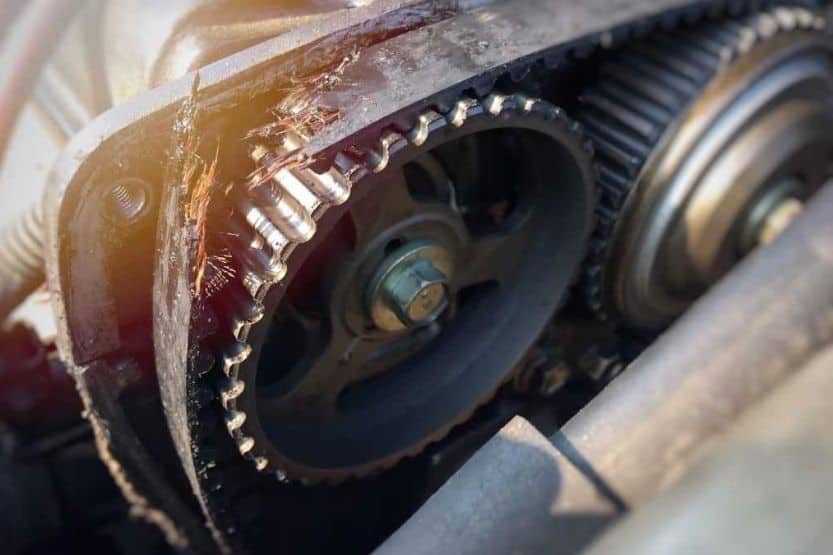You may have heard of a timing belt, but do you know what a serpentine belt is? What is the difference between a serpentine belt vs. timing belt?
The function of the serpentine belt is very different from the function of the timing belt. The timing belt is found inside the engine casing. The serpentine belt is located outside the engine.
The timing belt is connected directly to the engine and is driven by the crankshaft, which turns the camshaft. It makes the crankshaft and camshaft agree with each other and opens and closes the engine valves.
The serpentine belt is not connected directly to the engine. The belt runs the power accessories attached to the engine, such as the alternator, power steering pump, water pump, and air conditioner.
Read on to learn more about the contrast between the serpentine belt and the timing belt as well as their roles in the efficient performance of your car.
Serpentine Belt Vs. Timing Belt – What’s the Difference?
The serpentine belt is not connected directly to the engine. It runs the power accessories attached to the engine. The timing belt is connected directly to the engine and is driven by the crankshaft, which turns the camshaft.
There are several differences between the serpentine belt and the timing belt. Below are3 key differences between a timing belt vs. serpentine belt.
1. Connection to the Engine Is Different
Serpentine Belt
The serpentine belt is external to the car engine. It is connected to the power accessories that are not inherent parts of the engine. These accessories include the alternator, the power steering pump, the water pump, and the air conditioner.
If this belt snaps, you will still be able to drive your car – but only for a short distance. However, without the power accessories doing their individual work, the engine might overheat, the inside of the car will get hot, and you will not be able to travel very far.
Fortunately, a serpentine belt is inexpensive and easy to replace.
Timing Belt
On the other hand, the timing belt is directly connected to the engine through the crankshaft rod. Its role is to turn the crankshaft and the camshaft so that the engine valves inside the engine can open and close. This belt is encased in a steel casing and is very difficult to replace.
Most engines are designed so that the crankshaft and camshaft will not continue turning if this belt snaps. If they continue turning, the pistons inside the cylinders could hit any open valve and damage the engine. This is an expensive problem to solve.
While this belt is inexpensive and easily available, the work of replacing it is challenging. Your repair costs could run into hundreds of dollars to remove the broken belt and replace it with a new one. What if the engine is damaged?

2. Serpentine Belt Is Friction Drive While the Timing Belt Is Direct Drive
Timing belt vs. Serpentine – which one is friction and drive oriented?
Serpentine Belt
The serpentine belt is friction drive or friction oriented. The force that it generates depends on the friction between the belt and the pulleys’ surfaces it is turning. Its role is to drive or turn or rotate all the pulleys that are connected to it.
Timing Belt
In contrast, the timing belt is a direct drive. That means this belt is directly connected to the pulley of the crankshaft, which turns the camshaft. It is a cogged belt – meaning it has teeth on its inside parts.
The cogs of this belt should match the cogs or teeth on the pulley it is connected to. This design prevents the pulley from slipping under the belt. Thus, it can maintain the right synchronization between the crankshaft and the camshaft.
3. Cogs or Grooves Are Different
Serpentine vs. Timing belt – how do they compare in terms of grooves?
The grooves of the serpentine belt are V-shaped. They run vertically along the inside diameter of the belt.
Timing belts have horizontal grooves that are designed to fit the cogs or teeth of the crankshaft.
What Is a Serpentine Belt?
The serpentine belt is long and is made of reinforced rubber. It should have this kind of length because it has to be connected to at least seven pulleys of different diameters. It is called a serpentine belt because it twists, turns, and coils around to accommodate all the pulleys that it is connected to.
This belt is connected to the following:
- Alternator’s pulleys
- Water pump
- The compressor of the air conditioner
- Power steering pump
- Crankshaft
These components are called engine accessories. This is the reason why this belt is also called an accessory belt or fan belt.
Most modern cars typically use just one accessory or a serpentine belt. This belt winds through all the pulleys of these accessories to receive and transmit power from the original power source, which typically originates in the alternator.
Using just one belt to run all the accessories is cost-saving and efficient. However, if the belt snaps or breaks, all the accessories, even if they are working well, will not run or operate. The belt which transmits the power to them all is broken, that’s why.
It is essential for you to regularly check the serpentine belt in your car and have it replaced when it already shows signs of aging. It is relatively easy to replace and inexpensive to buy.
What Happens If the Serpentine Belt Goes Bad?
If you have a bad serpentine belt, your car engine will overheat and will eventually quit running. This belt usually fails when it is continuously contaminated with the coolant oil that leaks out from inside the engine. This occurs when the tensioner is transferring an incorrect amount of tension on the belt, causing it to be misaligned.
How Long Do Serpentine Belts Last?
Serpentine belts are sturdy, and most of them last very long. Under ideal conditions, they should last from 60,000 to 100,000 miles ((96,560 to 160,934 kilometers). While a serpentine belt is made to last, it is a good practice to include it in your preventive maintenance schedule.
Replace it when it’s already near the end of its service life. Don’t wait for it to break down before replacing it. You might be driving out on the highway, alone, when it snaps. If you’re not sure how many miles it has already run, have it checked by a qualified mechanic.
Symptoms of a Failing Serpentine Belt
No matter how sturdy this belt is, it will not last forever. Here are the signs that you need to watch out for:
- Presence of fraying, glazing, cracking, or any sign of wearing out;
- The Check Engine light comes on;
- A strange noise coming from the belt or pulleys;
- Reduced performance, e.g., stalled engine, an abrupt drain of the car battery, failure of power steering, and so forth; and
- Belt squeaks or chirps (could be caused by a slipping belt)

Serpentine belt vs. timing belt – what is the difference? A timing belt is responsible for turning the camshaft which in turn opens and closes the valves. It is located under the cover.
The serpentine belt is responsible for making the car’s accessories (e.g., water pump, alternator, air conditioner, power steering pump).
What Is a Timing Belt?
In automotive lingo, the timing belt refers to the belt connected to the pulley of the crankshaft. This belt makes the rotation of the crankshaft and the camshafts synchronize with each other.
It ensures that the engine’s valves open and closes at their proper time sequences during the intake and exhaust strokes of each cylinder.
This belt is made of a reinforced rubber band with vertical grooves or notches or teeth that run along its entire diameter. This belt is a direct drive as opposed to the external drive character of the serpentine belt.
In previous car engine designs, timing chains are used instead of timing belts. Rubber belts became the standard nowadays because of their remarkable flexibility. Chains wear and stretch easily.
Modern timing belts can last a long time, with some lasting up to 100,000 miles (163,934 km.).
Functions of the Timing Belt
Two components maintain the smooth operation of a car engine. One is the crankshaft, which moves the pistons up and down the cylinders of the engine. The other is the camshaft, which opens and closes the valves that allow the air and fuel mixture to enter the cylinders.
The piston’s complex movements and valves must be synchronized so that when the spark plugs introduce the sparks in the cylinders or burning chambers, the burning of the fuel will be properly timed or synchronized. If these movements are not synchronized, the engine will misfire, and the fuel efficiency and performance of the car will suffer.
This is the reason why the timing belt must be working properly. The engine component ensures the proper delivery of fuel in the amount and the exact time needed inside the engine’s chambers or cylinders. It ensures that the turning of the crankshaft and the camshaft is always at the right time.
Not All Vehicles Have Timing Belts
You should also know that there are vehicles that do not have timing belts. Some cars use timing chains instead of timing belts. Car owners will know if they have this chain if there is no mention of timing belt maintenance in their car owner’s manual. Most likely, their cars have timing chains.
This belt chain is made of metal, but it performs the same function as rubber timing belts. They seldom need replacement. But since they are made of metal, they are noisier and heavier. This kind of chain is not common in modern cars.
How Long Do Timing Belts Last?
In most modern cars, the timing belt can last 100,000 m. (163,934 km.). Timing belts for older models usually last 60,000 m. (96,560 km.). But when the water pump is failing, you should also replace the timing belt.
The reason is that typically, you have to remove the timing belt before you can remove and replace the bad water pump.
Here are some of the things you should watch out for when you have a malfunctioning timing belt:
- A malfunctioning timing belt is worse than a bad serpentine belt. If your car has a bad timing belt, replace it right away. If you don’t, you face the risk of damaging your car.
The repair expense could be in such an amount that will really hurt your pocket;
- A bad timing belt can cause the valves of the engine to stay open. If the engine is running and the piston is on its upward cycle, it will hit the valve.
Imagine all the valves and pistons out of sync. When this happens, you have a disaster in your hands.
- Oil leaks and overheated engines are two of the most serious enemies of timing belts. You can maintain the timing belt’s integrity if you regularly check the engine bay and observe the right modes of driving.
Symptoms of a Failing Timing Belt

Here are the symptoms that you’re timing belt is failing:
1. Slip
A worn-out timing belt will cause it to slip. If that happens, there will be incorrect misfiring of the fuel inside the engine’s combustion chambers. Unfortunately, there are no clear indications of a deteriorating timing belt. Failure of the timing belt seems to occur suddenly. It is not as gradual as in the case of the serpentine belt.
2. Engine Will Lose Power
But once the timing belt fails, the engine will lose power and suddenly stop. If your car has a timing chain, you won’t fail to hear it cracking or breaking inside the engine bay. The noise that it will create as it hits the other engine parts will be frightening.
If you don’t want this to happen, follow the recommended timing belt preventive maintenance schedule of the car’s manufacturer. Checking the belt regularly will enable you to evaluate its condition. You will be able to gauge when it needs to be replaced.
Conclusion: Timing Belt Vs. Serpentine Belt
Serpentine belt vs. timing belt – are they the same? The serpentine belt is not directly connected to the engine. It is the belt that runs the accessories that are attached to the engine.
These accessories include the alternator, the power steering pump, the water pump, and the air conditioner.
The timing belt is directly connected to the engine. It is driven by the crankshaft and turns the camshaft of the engine. This belt keeps the camshaft and crankshaft in sync and also opens and closes the engine valves.
Related reading:

![Bad Timing Belt Symptoms [6 Main Symptoms] Bad Timing Belt Symptoms](https://roadsumo.com/wp-content/uploads/2021/09/bad-timing-belt-symptoms-150x150.jpg)







